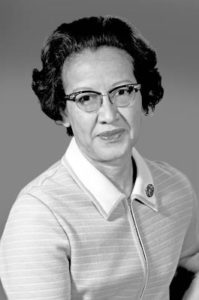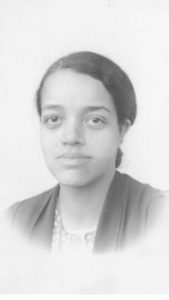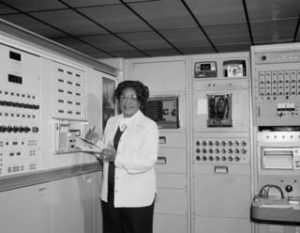This year for Women’s History Month, we are highlighting different women each week who, although you may have not heard of previously, have contributed greatly to society.
This week we are shining light on Katherine Johnson, Dorothy Vaughan and Mary Jackson, three women who played a vital role in advancing NASA’s missions. These African American women computers played a vital role in 1962, when they helped send the first American astronaut into orbit, John Glenn. You may have heard about their story from the 2016 film Hidden Figures.

Katherine Johnson was born on Aug. 26, 1918 in White Sulphur Springs, WV. Her brilliance with numbers shone early on and vaulted her ahead several grades in school, and by 13, she was attending high school. At 18, she enrolled in the historically black West Virginia State College, where she graduated with highest honors in 1937 and took a job teaching at a black public school in Virginia. She left her teaching job and enrolled in the graduate math program in 1939. Katherine was one of the three black students handpicked to integrate West Virginia’s graduate schools. At the end of the first session, however, she decided to leave school to start a family with her first husband, James Goble.
It wasn’t until 1952 that she heard about open positions at the all-black West Area Computing section at the National Advisory Committee for Aeronautics’ (NACA’s) Langley laboratory, headed by fellow West Virginian Dorothy Vaughan. Katherine and her husband moved to Virginia to pursue the opportunity, where Katherine spent the next four years analyzing data from flight tests until her husband died of cancer in December 1956.
The 1957 launch of the Soviet satellite Sputnik changed history—and her life. She worked on and published several papers with engineers that formed the core of the Space Task Group, the NACA’s (later becoming NASA in 1958) first official foray into space travel.
In 1962, as NASA prepared for the orbital mission of John Glenn, Katherine was called upon to do the work that she would become most known for. As a part of the preflight checklist, Glenn asked engineers to “get the girl”—Katherine Johnson—to run the same numbers through the same equations that had been programmed into the computer, but by hand. “If she says they’re good,’” Katherine remembers the astronaut saying, “then I’m ready to go.” The flight was a success and marked a turning point in the competition between the United States and the Soviet Union in space.
Katherine retired in 1986, after 33 years at Langley. “I loved going to work every single day,” she said. In 2015, at age 97, President Barack Obama awarded her the Presidential Medal of Freedom, America’s highest civilian honor. She died on Feb. 24, 2020, at 101 years old – an American hero who’s pioneering legacy will never be forgotten.

Born Sept.20, 1910, in Kansas City, MO. those who speak of NASA’s pionefers rarely mention the name Dorothy Vaughan, but as the head of the National Advisory Committee for Aeronautics’ (NACA’s) segregated West Area Computing Unit from 1949 until 1958, Vaughan was both a respected mathematician and NASA’s first African American manager.
Dorothy Vaughan came to the Langley Memorial Aeronautical Laboratory in 1943, during the height of World War II, leaving her position as the math teacher at Robert Russa Moton High School in Farmville, VA to take what she believed would be a temporary war job. Two years after President Roosevelt signed Executive Order 8802 into law, prohibiting racial, religious and ethnic discrimination in the country’s defense industry, the Laboratory began hiring black women to meet the skyrocketing demand for processing aeronautical research data.
Dorothy Vaughan was assigned to the segregated “West Area Computing” unit, an all-black group of female mathematicians. Over time, both individually and as a group, the West Computers distinguished themselves with contributions to virtually every area of research at Langley.
Dorothy Vaughan helmed West Computing for nearly a decade. In 1958, when the NACA made the transition to NASA, segregated facilities, including the West Computing office, were abolished. Dorothy Vaughan and many of the former West Computers joined the new Analysis and Computation Division, a racially and gender-integrated group on the frontier of electronic computing.
Retiring from NASA in 1971, her legacy lives on in the successful careers of notable West Computing alumni, including Mary Jackson, Katherine Johnson, Eunice Smith and Kathryn Peddrew, and the achievements of second-generation mathematicians and engineers such as Dr. Christine Darden.

Last, but certainly not least, is Mary Jackson. Born April 9, 1921, Mary grew up in Hampton, VA. After graduating with highest honors from high school, she then continued her education at Hampton Institute, earning her Bachelor of Science Degrees in Mathematics and Physical Science.
Mary’s path to an engineering career at NASA took several turns. After graduating she was a math teacher at a black school in Maryland. After a year of teaching, Mary returned home, finding a position as the receptionist at the USO Club, as a bookkeeper in Hampton Institute’s Health Department, a stint at home following the birth of her son, Levi, and a job as an Army secretary—before Mary landed at the Langley Memorial Aeronautical Laboratory’s segregated West Area Computing section in 1951, reporting to the group’s supervisor Dorothy Vaughan.
After two years in the computing pool, Mary received an offer to work for engineer Kazimierz Czarnecki in the 4-foot by 4-foot Supersonic Pressure Tunnel. Czarnecki offered Mary hands-on experience with experiments in the facility, and eventually suggested that she enter a training program that would allow her to earn a promotion from mathematician to engineer. Mary completed the courses, earned the promotion, and in 1958 became NASA’s first black female engineer.
Mary began her engineering career in an era in which female engineers of any background were a rarity, and may have been the only black female aeronautical engineer in the field. In 1979, seeing that the glass ceiling was the rule rather than the exception for the center’s female professionals, she made a final, dramatic career change, leaving engineering and taking a demotion to fill the open position of Langley’s Federal Women’s Program Manager. There, she worked hard to impact the hiring and promotion of the next generation of all of NASA’s female mathematicians, engineers and scientists.
Mary retired from the NASA Langley Research Center in 1985 as an Aeronautical Engineer after 34 years. Among her many honors were an Apollo Group Achievement Award and being named Langley’s Volunteer of the Year in 1976. A 1976 Langley Researcher profile might have done the best job capturing Mary’s spirit and character, calling her a “gentlelady, wife and mother, humanitarian and scientist.” For Mary Jackson, science and service went hand in hand.
Sources:
• Katherine Johnson Biography | NASA
• Dorothy Vaughan Biography | NASA
• Mary Jackson Biography | NASA
